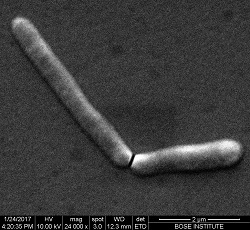Complex Systems

In many real world systems, networks constitute the architecture of complexity and often exhibit a modular structure. Apart from our research goals in quantum networks, we have successfully applied networks towards image processing and diagnostics, and, uncovered ways to detect vulnerabilities in them.

Rational design of synthetic photo receptors is of immense importance in optogenetics. Introduction of the theoretical framework of differential networks helps in finding the distribution of functionally important residues. Above image illustrates such residues for Aureo1 LOV (dimer) before illumination.
Faculty members associated with this programme:
Somshubhro Bandyopadhyay
Suman Banik
Jayanta Mukhopadhyay
Rajarshi Ray
Soumen Roy

Ongoing research:
Can Mycobacterial cells be made phage resistant? Above image demonstrates a scanning electron microscopy image of such a cell being studied by us while undergoing asymmetrical division.

Ongoing research:
Simultaneous mathematical and experimental study of the dynamics of complex pattern formations in microbial systems. Image shows a colony of Bacillus subtilis grown on M9 media.